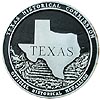Few in numbers and with little protection from the military but refusing to abandon their country, certain families of courageous and determined people on the Texas frontier during the Civil War gathered together in hastily constructed stockades and held out against the threats of hostile Indians and renegade whites. Known as forting up, this plan was encouraged by the military for this part of the state. Most of the men 18 to 45 were away in Confederate service and those 17 and over 45 were subject to periodic militia duty for frontier protection. Family forts gave settlers a way to protect stock, farms and provide some schooling for their children. Back of Family Forts, C.S. A. Best-known family fort in this sector was Fort Davis, located 8 miles east on bank of Clear Fork of Brazos in Stephens County, where some 120 people lived during last year of Civil War. Named for Confederate President Jefferson Davis, it was laid off in lots. Log houses with dirt roofs, mud in cracks, dirt floors, were connected by pickets driven into ground. A blockhouse was used by women and children during raids. There were no luxuries, little food, all clothes, soap, soda, candles were made. Nearest supplies were 100 miles away, doctor 65 miles. Yet, there were dances, candy pulls, weddings, feasts, Sunday School, occasional sermons and blue-backed spellers. Other family forts near were: Lynch and Green ranches, Shackelford County, Blair's Fort, Allen's Ranch, Eastland County; Buffalo Springs, Clay County; Bragg's, Murray's, Young County; Picketville, Mugginsville, Owls Head, Stephens County. Erected by the State of Texas, 1963.
This page last updated: 7/15/2008 |
Family Forts, C.S.A. Historical Marker Location Map, Albany, Texas
|
|
Related Themes: Texas C.S.A., Texas Confederate States of America, Confederacy
Explore other
Texas Confederate Historical Markers.
|


